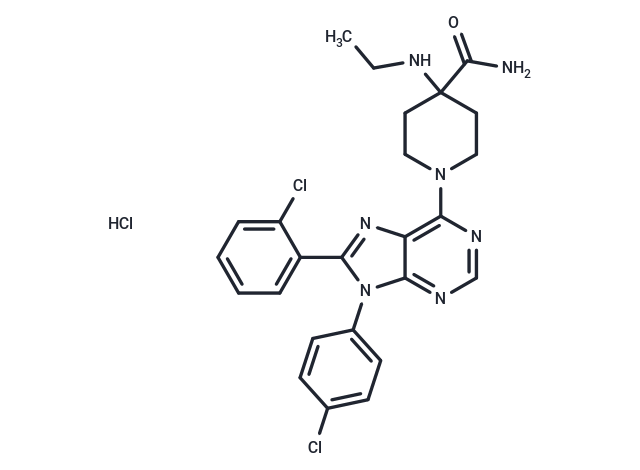Shopping Cart
- Remove All
 Your shopping cart is currently empty
Your shopping cart is currently empty

Otenabant hydrochloride (Otenabant) (CP-945598) is a competitive, high affinity, selective antagonist of the CB1 receptor (Ki: 0.7 nM).

| Pack Size | Price | Availability | Quantity |
|---|---|---|---|
| 1 mg | $39 | In Stock | |
| 2 mg | $54 | In Stock | |
| 5 mg | $74 | In Stock | |
| 10 mg | $123 | In Stock | |
| 25 mg | $252 | In Stock | |
| 50 mg | $466 | In Stock | |
| 100 mg | $683 | In Stock |
| Description | Otenabant hydrochloride (Otenabant) (CP-945598) is a competitive, high affinity, selective antagonist of the CB1 receptor (Ki: 0.7 nM). |
| Targets&IC50 | CB1 (rat):2.8 nM(Ki), CB1 (human):0.7 nM(Ki) |
| In vitro | In a diet-induced obesity model in mice, CP-945598 (10 mg/kg) facilitated a 9% reduction in body weight over a 10-day weight loss study. CP-945598 significantly enhanced energy expenditure in rats and reduced the respiratory quotient, indicating a metabolic shift towards increased fat oxidation. Additionally, CP-945598 HCl reversed behaviors mediated by four cannabinoid agonists (hypothermia, spontaneous activity, catalepsy, and analgesia). In acute food intake models in rodent species, CP-945598 HCl suppressed appetite, further promoting fat oxidation and energy consumption. |
| In vivo | CP-945598 HCl exhibits lower affinity towards human CB2 receptors (Ki: 7.6 μM) and demonstrates inhibitory effects on the CB1 receptor. Additionally, it possesses moderate microsomal clearance, low affinity for hERG, and sufficient penetration of the central nervous system (CNS). |
| Kinase Assay | Membranes are prepared from CHOK1 cells stably transfected with the human CB-1 receptor cDNA. GTPγ [35S] binding assays are performed in a 96-well FlashPlate format in duplicate using 100 pM GTPγ [35S] and 10μg membrane per well in assay buffer composed of 50 mM Tris HCl, pH 7.4, 3 mM MgCl2, pH 7.4, 10 mM MgCl2, 20 mM EGTA, 100 mM NaCl, 30 μM GDP, 0.1% bovine serum albumin, and the following protease inhibitors: 100 μg/mL bacitracin, 100 μg/mL benzamidine, 5 μg/mL aprotinin, 5 μg/mL leupeptin. The assay mix is then incubated with increasing concentrations of antagonist (10-10M to 10-5 M) for 10 min and challenged with the cannabinoid agonist CP-55,940 (10 μM). Assays are performed at 30°C for 1 h. The FlashPlates are then centrifuged at 2000 g for 10 min. Stimulation of GTPγ [35S] binding is then quantified using a Wallac Microbeta. EC50 calculations are done using Prism by GraphPad. Inverse agonism is measured in the absence of agonist. |
| Alias | Otenabant (CP-945598) HCl, Otenabant, CP 945598 Hydrochloride |
| Molecular Weight | 546.88 |
| Formula | C25H26Cl3N7O |
| Cas No. | 686347-12-6 |
| Smiles | Cl.CCNC1(CCN(CC1)c1ncnc2n(c(nc12)-c1ccccc1Cl)-c1ccc(Cl)cc1)C(N)=O |
| Relative Density. | no data available |
| Storage | Powder: -20°C for 3 years | In solvent: -80°C for 1 year | Shipping with blue ice. |
| Solubility Information | DMSO: Slightly soluble |

Copyright © 2015-2025 TargetMol Chemicals Inc. All Rights Reserved.